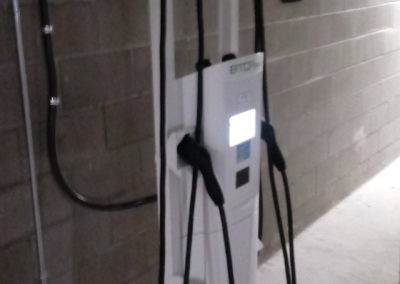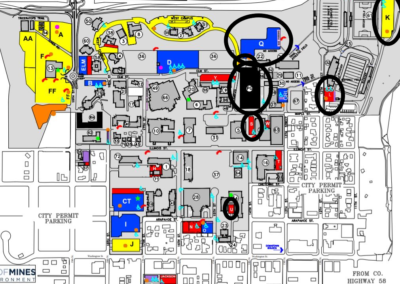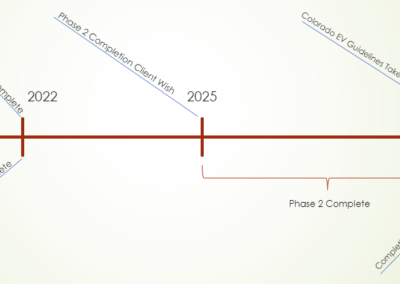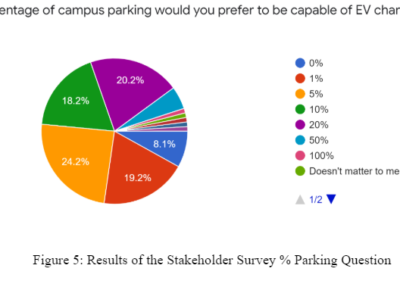EV Charging Strategy
Overview
The team was tasked with creating a strategy to implement more Electric Vehicle (EV) charging capability on campus as the demand and usage of EVs grows. In our first semester working on the project, we created a short term plan that placed more EV chargers in parking lots that are expected to remain for the next 5 years. In our second semester, we took a closer look at the best practices are surrounding EV charger use and how we should approach the implantation of chargers in the future. As the size of the demand and usage of EVs in the future is uncertain we decided on a plan that implements more chargers slowly at first adding them one or two at a time with available grant money and responding to the demand with larger numbers of chargers as needed. Final deliverables include: a budget detailing the cost of a large EV hub in K-Lot as well as an individual budget detailing the costs of a single charger unit, site layouts and construction plans, and general recommendations for future EV chargers.
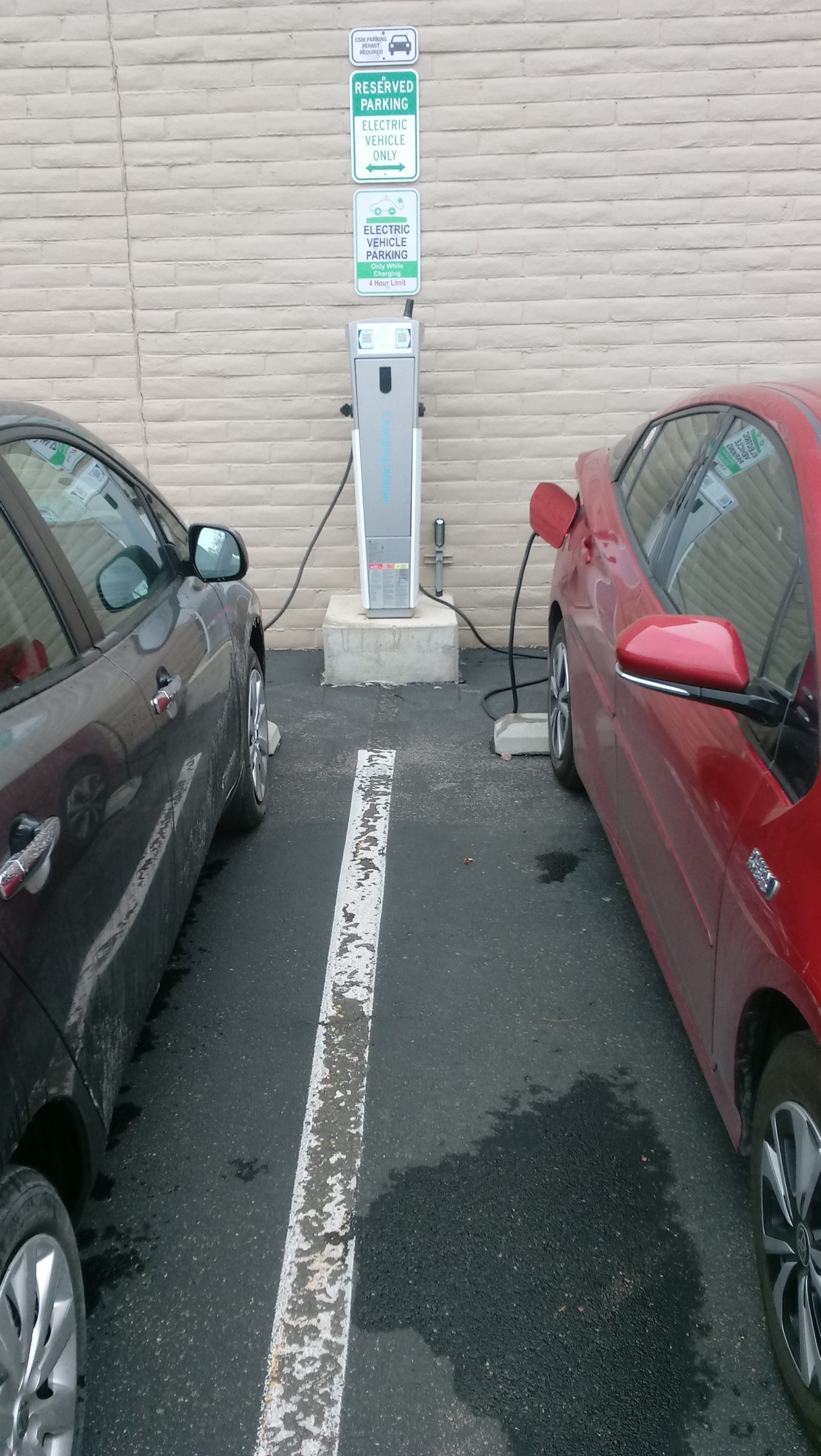
Live Zoom Chat
Use the link below to join us live from 8:00 – 10:30 a.m. on April 29th.
https://mines.zoom.us/j/98022361007?pwd=dVp5ZzRwWjJiU3JPREFLRFNyZEhwQT09
Please use passcode: EVCHARGE
Or iPhone one-tap: 13462487799,98022361007# or 16699006833,98022361007#
Or Telephone:
Dial: +1 346 248 7799 (US Toll) or +1 669 900 6833 (US Toll)
Meeting ID: 980 2236 1007
Password: 57446494
International numbers available: https://mines.zoom.us/u/adO6DRbcCp
Team Members
- Ben Thatcher
- Nathaniel Sunshine
- Lucas Buck
- Allee Beach
- Sean LaChance
The Client
- Colorado School of Mines
- Contact: Lauren Poole
Acknowledgements
Project Advisor: Prof. David Grimm
Technical Advisors: Samuel Crispin, Mike Bowker,
Paulo Cesar Tabares Velasco, Dave Barry, Steve Trowbridge, Ian Markovitz, Lauren Poole
Video
Elevator Pitch
Hello my name is Lucas Buck and I am a member of the Recharge capstone team here to tell you about our project!
Do you like driving your gas powered vehicle, but hate those nasty pollutants that are destroying our planet? Well luckily, Car companies around the world are developing innovative electric vehicles that will soon be affordable for everyone.
However, electric vehicles need a whole network of charging stations to meet the demands of their users. Colorado expects enough EV charging stations to host thousands of vehicles, and Mines pledges to help the cause.
Our senior design team was tasked with designing a plan to convert 20% of parking spaces on campus into electric vehicle charging stations. This project is set over the next 10 years and includes apprximately 2 million dollars of infrastructure. Although we cannot predict the evolution of electric vehicles over the next decade, we gave our client as many resources as possible to make the best decisions moving forward.
Challenges for this project include: keeping student parking accessible, a limited budget, developing a system for effectively transporting power, and future proofing the design.
Overall, our team was successful in collecting a large amount of data about EVs and charging stations which allowed us to create a specialized plan for our very unique institution. Campus is changing, and we designed around that. We advise constructing 3 large hubs of chargers for the student and local community members alike located in parking garage 1, k lot and one more in the soon-to-be-built parking garage which will be on the south end of campus. These locations will balance the necessary capacity of charger with the needs of the community and help better prepare the campus for the oncoming future. This project took many hours over hard work, but was enjoyable for all members involved. Thank you for listening and have a great day.
Design Approach
Throughout the two semesters of this project, team reCharge went through two different phases. The first phase of the project was aimed at considering where the Electric Vehicle chargers would be placed across campus. During this process it was extremely important to consider stakeholders. To engage with stakeholders we created a google survey and gained insight into the desire for EV chargers and concerns surrounding them. Along with this, the group had to reach out to staff members of the Colorado School of Mines to determine what the future construction plans were. With so much growth on campus and parking lots changing, it was important to find out which locations these EV chargers would have a chance to be placed in the future. We concluded this first phase by creating some plans for the parking that is planned to exist after Mines’ Master Plan is implemented. It contained 157 chargers to bring the surviving parking up to 20% of spaces having access to an EV charger.
The second phase of this project included more technical work. A large part was determining what each parking lot project would require, such as: electrical equipment, construction, trenching, how many chargers, and implementation plans. This all was considered when calculating budgets for each parking lot. Since the demand for EV chargers could change drastically in the coming years examining the costs on a lot-by-lot basis gives future architects actionable information when deciding where to put EV chargers when there is a demand for them.
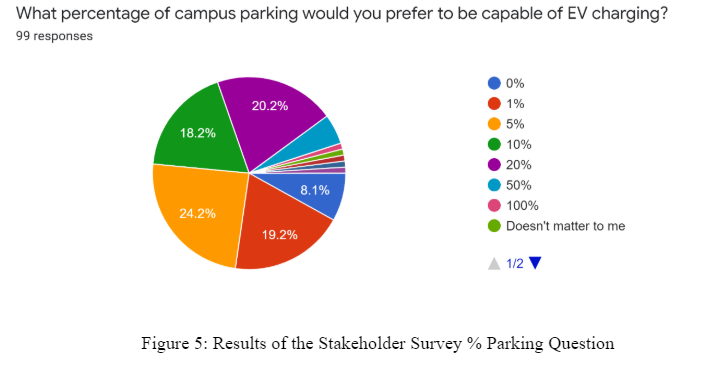
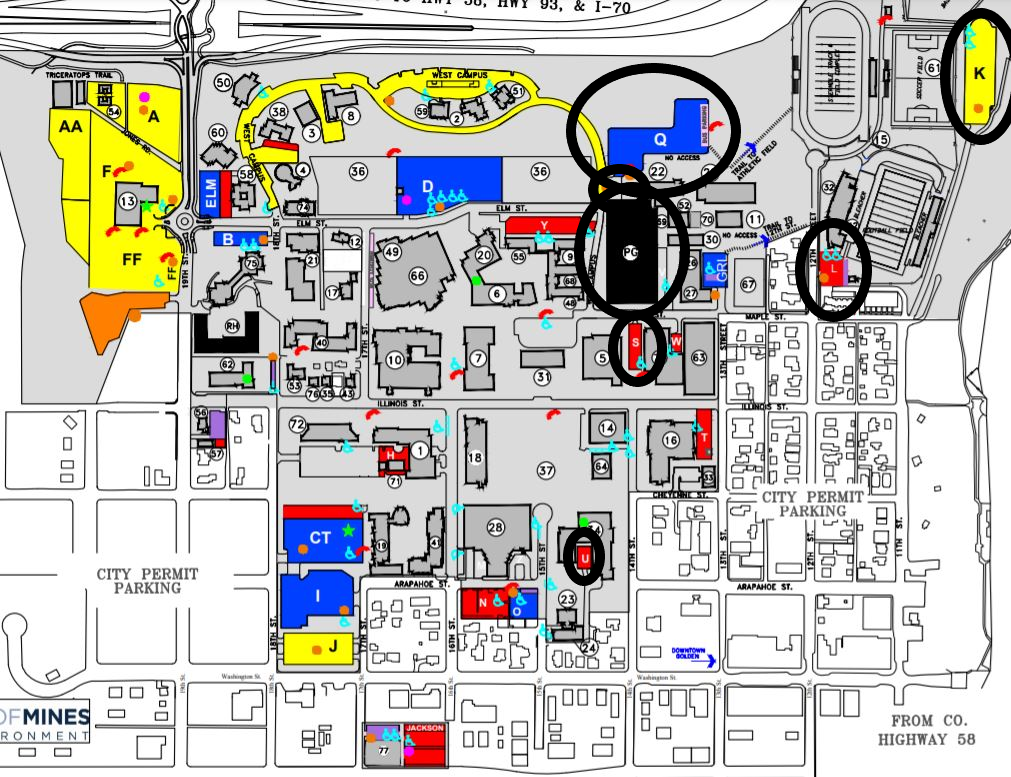
Design Solution
The outcome of the project included flexible options for the Colorado School of Mines administration to choose from. The goal of the project was to recommend a plan that would meet the criteria that 20% of the remaining parking on campus would be designated for Electric Vehicle charging stations. It was determined that 20% of remaining parking would entail 276 charging spots. Through consideration of stakeholders, requests of the sustainability committee and careful consideration, table 1 shows the recommended placement of the charging stations.
K lot was chosen as a hub, housing 69 chargers (138 spots), because of its accessibility to the town of Golden as well as the Mines campus. Q lot was chosen because it would not interfere with central campus parking spaces.
In total, this project is going to require a budget of about $2,079,018 this number was found using a PERT Budget table. We found that the Construction itself will cost $365,029, this includes material, labor, and Engineering costs. The chargers and mounting kits will cost $1,024,961. Services by the charger company will cost $554,082. This budget finally has a 9% contingency.
The price of electricity for the Mines campus was determined to be $0.09 per kilowatt hour. For this reason, we recommend that a fee of $0.15 per kilowatt hour be charged for use of the EV chargers. This $0.06 per kilowatt hour of revenue can be used toward the recuperating of costs from the installation of the chargers.
The ChargePoint chargers which we used for our cost and power calculations can be conveniently manipulated through ChargePoint’s webservices to implement the fee structure discussed above as well as control the output of the chargers in the event that the campus needs to run on backup power.

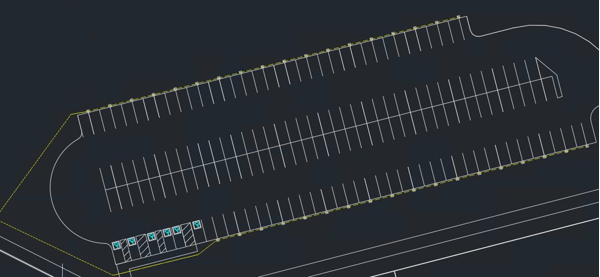
Next Steps
Depending on the demand for EV Charging on campus more chargers should be constructed on campus. CSM has been applying for grants to buy some chargers, but if the goal of 20% capability remains reasonable then these grants will not be enough to cover a large expense such as the total 2 million that we calculated. For the most part, our work on this project did not include parking that will be constructed in the future, so it may be logical to reexamine the information we have when new parking structures are being constructed and build them with the intent of placing chargers inside to reach 20% campus-wide EV capability. To monitor and make needed construction plans a good next step would be to form a committee to implement EV charging on campus.
Meet the Team
Ben Thatcher
 Ben is an EE major with a minor in computer engineering. He served as the communication lead for the team and did most of his work on background research and details of the electrical needs of a charging system in the first semester working on this project. In the second semester, he reexamined and refined power calculations for each lot and analyzed fee structures. In his spare time, he enjoys backpacking and playing videogames.
Ben is an EE major with a minor in computer engineering. He served as the communication lead for the team and did most of his work on background research and details of the electrical needs of a charging system in the first semester working on this project. In the second semester, he reexamined and refined power calculations for each lot and analyzed fee structures. In his spare time, he enjoys backpacking and playing videogames.
Nathaniel Sunshine
 Nathaniel Sunshine is a graduating Mechanical Engineering Major. During the first semester, he coordinated the community outreach, determined the lots to be used in the project, and created the initial charger layouts. In the second semester, he was focused mainly on refining the budget and measuring the lots for construction. In his free time, Nathaniel likes to watch all kinds of sports and enjoys Comics and movies.
Nathaniel Sunshine is a graduating Mechanical Engineering Major. During the first semester, he coordinated the community outreach, determined the lots to be used in the project, and created the initial charger layouts. In the second semester, he was focused mainly on refining the budget and measuring the lots for construction. In his free time, Nathaniel likes to watch all kinds of sports and enjoys Comics and movies.
Lucas Buck
 I am extremely grateful for the opportunity to contribute to the Mines community during my senior design course. Improving the surrounding environment is one component of engineering and being able to see the impacts of our project on the campus is very rewarding. The many challenges I was exposed to through this course should help me in my future endeavors as an engineer. Moreover, the importance of clear and concise communication with stakeholders was a skill that I was exposed to many times throughout the past year. In summary, the challenge of designing electric vehicle infrastructure made my senior year exciting and challenging
I am extremely grateful for the opportunity to contribute to the Mines community during my senior design course. Improving the surrounding environment is one component of engineering and being able to see the impacts of our project on the campus is very rewarding. The many challenges I was exposed to through this course should help me in my future endeavors as an engineer. Moreover, the importance of clear and concise communication with stakeholders was a skill that I was exposed to many times throughout the past year. In summary, the challenge of designing electric vehicle infrastructure made my senior year exciting and challenging
Allee Beach
 Allee Beach is a senior graduating as an Electrical Engineering Major in spring 2021. She is also a part of the Colorado School of Mines Track and Field team. Throughout her years at Mines she has been involved with SWE and IEEE as well. She enjoys contributing through community service, and has been involved with the Special Olympics program through CSM. Her passion for renewable energy has aided in her 2 senior design projects that made up her senior year. This is her first semester on the EV charging strategy team, and was a part of the Solar Feasibility study of Mines Park in Fall 2020.
Allee Beach is a senior graduating as an Electrical Engineering Major in spring 2021. She is also a part of the Colorado School of Mines Track and Field team. Throughout her years at Mines she has been involved with SWE and IEEE as well. She enjoys contributing through community service, and has been involved with the Special Olympics program through CSM. Her passion for renewable energy has aided in her 2 senior design projects that made up her senior year. This is her first semester on the EV charging strategy team, and was a part of the Solar Feasibility study of Mines Park in Fall 2020.
Sean LaChance
 Sean worked on the preliminary design phase of this project in the fall and graduated with a degree in Electrical Engineering with a focus in Power and Energy Systems. He primarily worked on power calculations for the preliminary plan and researching budget information surrounding transformers.
Sean worked on the preliminary design phase of this project in the fall and graduated with a degree in Electrical Engineering with a focus in Power and Energy Systems. He primarily worked on power calculations for the preliminary plan and researching budget information surrounding transformers.

